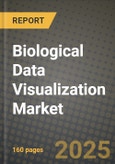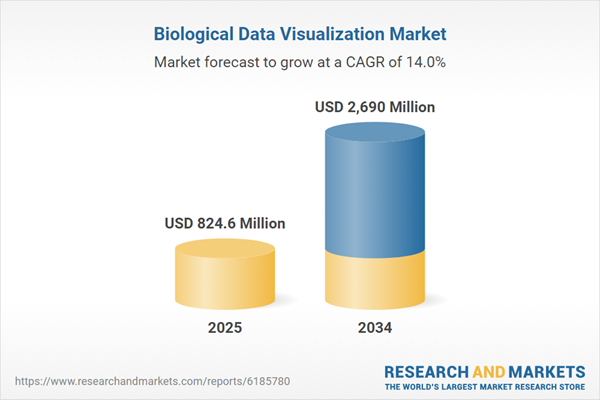The biological data visualization market has emerged as a critical component of the life sciences and healthcare industries. Researchers and healthcare professionals rely on advanced visualization tools to interpret complex biological datasets, such as genomic sequences, proteomic profiles, and cellular imaging. These tools help identify patterns, correlations, and anomalies, enabling more accurate diagnosis, targeted drug development, and personalized treatment strategies. As the volume of biological data continues to grow exponentially, demand for innovative visualization solutions has skyrocketed, driving the market’s rapid expansion.
Technological advancements have played a pivotal role in shaping the biological data visualization market. The integration of artificial intelligence (AI) and machine learning (ML) with visualization platforms has enhanced the ability to process, analyze, and visualize large, multidimensional datasets. Interactive 3D rendering, real-time analytics, and web-based visualization tools have made it easier for researchers and clinicians to collaborate and share insights across teams and institutions. Furthermore, the rise of single-cell and spatial omics techniques has spurred the development of specialized visualization tools that cater to these cutting-edge methodologies, broadening the market’s scope and application areas.
Regionally, North America dominates the biological data visualization market, driven by a well-established life sciences sector, robust funding for research and development, and widespread adoption of advanced analytics and AI technologies. Europe follows closely, with strong government support for genomic initiatives and growing investments in bioinformatics. The Asia-Pacific region is experiencing rapid growth, fueled by increasing research activities, expanding healthcare infrastructure, and rising awareness of precision medicine. As biological data becomes more complex and abundant, the market for advanced visualization tools is set to expand further, offering innovative solutions to accelerate discoveries, improve patient outcomes, and advance scientific understanding.
Key Insights: Biological Data Visualization Market
- Increasing use of AI and ML algorithms to enhance biological data visualization and interpretation.
- Rising adoption of single-cell and spatial omics visualization tools to analyze complex cellular landscapes.
- Development of user-friendly, web-based visualization platforms to facilitate remote collaboration and data sharing.
- Rapid growth in biological data volume and complexity, necessitating advanced visualization solutions.
- Ongoing technological advancements in genomic sequencing, proteomics, and imaging techniques.
- Increased investment in precision medicine and personalized healthcare initiatives.
- High computational and storage requirements associated with processing large biological datasets.
- Steep learning curve for researchers unfamiliar with advanced visualization software and tools.
- Integration challenges when combining multiple data types and sources into a unified visualization framework.
Biological Data Visualization Market Segmentation
By Technique
- Microscopy
- Magnetic Resonance Imaging
- Sequencing
- X-Ray Crystallography
- Other Techniques
By Platform
- Windows
- Mac Operating System
- Linux
- Other Platforms
By Application
- Cell and Organism Imaging
- Structural Biology and Molecular Modeling
- Genomic Analysis
- Alignments
- Phylogeny
- and Evolution
- Systems Biology
By End Use
- Academic Research
- Pharmaceutical and Biological Centers
- Hospitals and Clinics
- Other End Uses
Key Companies Analysed
- Thermo Fisher Scientific Inc.
- Danaher Corporation
- Becton Dickinson and Company (BD)
- GE HealthCare Technologies Inc.
- Agilent Technologies Inc.
- PerkinElmer Inc.
- Illumina Inc.
- Sartorius AG
- Nikon Corporation
- Waters Corporation
- Bio-Rad Laboratories Inc.
- Bruker Corporation
- Carl Zeiss Meditec AG
- QIAGEN N.V.
- Bio-Techne Corporation
- Leica Microsystems
- Promega Corporation
- 10x Genomic Inc.
- Luminex Corporation
- Abcam plc
- Oxford Nanopore Technologies Ltd.
- Cell Signaling Technology Inc.
- Pacific Biosciences of California Inc.
- NanoString Technologies Inc.
- Fluidigm Corporation
Biological Data Visualization Market Analytics
The report employs rigorous tools, including Porter’s Five Forces, value chain mapping, and scenario-based modeling, to assess supply-demand dynamics. Cross-sector influences from parent, derived, and substitute markets are evaluated to identify risks and opportunities. Trade and pricing analytics provide an up-to-date view of international flows, including leading exporters, importers, and regional price trends.Macroeconomic indicators, policy frameworks such as carbon pricing and energy security strategies, and evolving consumer behavior are considered in forecasting scenarios. Recent deal flows, partnerships, and technology innovations are incorporated to assess their impact on future market performance.
Biological Data Visualization Market Competitive Intelligence
The competitive landscape is mapped through proprietary frameworks, profiling leading companies with details on business models, product portfolios, financial performance, and strategic initiatives. Key developments such as mergers & acquisitions, technology collaborations, investment inflows, and regional expansions are analyzed for their competitive impact. The report also identifies emerging players and innovative startups contributing to market disruption.Regional insights highlight the most promising investment destinations, regulatory landscapes, and evolving partnerships across energy and industrial corridors.
Countries Covered
- North America - Biological Data Visualization market data and outlook to 2034
- United States
- Canada
- Mexico
- Europe - Biological Data Visualization market data and outlook to 2034
- Germany
- United Kingdom
- France
- Italy
- Spain
- BeNeLux
- Russia
- Sweden
- Asia-Pacific - Biological Data Visualization market data and outlook to 2034
- China
- Japan
- India
- South Korea
- Australia
- Indonesia
- Malaysia
- Vietnam
- Middle East and Africa - Biological Data Visualization market data and outlook to 2034
- Saudi Arabia
- South Africa
- Iran
- UAE
- Egypt
- South and Central America - Biological Data Visualization market data and outlook to 2034
- Brazil
- Argentina
- Chile
- Peru
Research Methodology
This study combines primary inputs from industry experts across the Biological Data Visualization value chain with secondary data from associations, government publications, trade databases, and company disclosures. Proprietary modeling techniques, including data triangulation, statistical correlation, and scenario planning, are applied to deliver reliable market sizing and forecasting.Key Questions Addressed
- What is the current and forecast market size of the Biological Data Visualization industry at global, regional, and country levels?
- Which types, applications, and technologies present the highest growth potential?
- How are supply chains adapting to geopolitical and economic shocks?
- What role do policy frameworks, trade flows, and sustainability targets play in shaping demand?
- Who are the leading players, and how are their strategies evolving in the face of global uncertainty?
- Which regional “hotspots” and customer segments will outpace the market, and what go-to-market and partnership models best support entry and expansion?
- Where are the most investable opportunities - across technology roadmaps, sustainability-linked innovation, and M&A - and what is the best segment to invest over the next 3-5 years?
Your Key Takeaways from the Biological Data Visualization Market Report
- Global Biological Data Visualization market size and growth projections (CAGR), 2024-2034
- Impact of Russia-Ukraine, Israel-Palestine, and Hamas conflicts on Biological Data Visualization trade, costs, and supply chains
- Biological Data Visualization market size, share, and outlook across 5 regions and 27 countries, 2023-2034
- Biological Data Visualization market size, CAGR, and market share of key products, applications, and end-user verticals, 2023-2034
- Short- and long-term Biological Data Visualization market trends, drivers, restraints, and opportunities
- Porter’s Five Forces analysis, technological developments, and Biological Data Visualization supply chain analysis
- Biological Data Visualization trade analysis, Biological Data Visualization market price analysis, and Biological Data Visualization supply/demand dynamics
- Profiles of 5 leading companies - overview, key strategies, financials, and products
- Latest Biological Data Visualization market news and developments
Additional Support
With the purchase of this report, you will receive:- An updated PDF report and an MS Excel data workbook containing all market tables and figures for easy analysis.
- 7-day post-sale analyst support for clarifications and in-scope supplementary data, ensuring the deliverable aligns precisely with your requirements.
- Complimentary report update to incorporate the latest available data and the impact of recent market developments.
This product will be delivered within 1-3 business days.
Table of Contents
Companies Mentioned
- Thermo Fisher Scientific Inc.
- Danaher Corporation
- Becton Dickinson and Company (BD)
- GE HealthCare Technologies Inc.
- Agilent Technologies Inc.
- PerkinElmer Inc.
- Illumina Inc.
- Sartorius AG
- Nikon Corporation
- Waters Corporation
- Bio-Rad Laboratories Inc.
- Bruker Corporation
- Carl Zeiss Meditec AG
- QIAGEN N.V.
- Bio-Techne Corporation
- Leica Microsystems
- Promega Corporation
- 10x Genomic Inc.
- Luminex Corporation
- Abcam PLC
- Oxford Nanopore Technologies Ltd.
- Cell Signaling Technology Inc.
- Pacific Biosciences of California Inc.
- NanoString Technologies Inc.
- Fluidigm Corporation
Table Information
| Report Attribute | Details |
|---|---|
| No. of Pages | 160 |
| Published | October 2025 |
| Forecast Period | 2025 - 2034 |
| Estimated Market Value ( USD | $ 824.6 Million |
| Forecasted Market Value ( USD | $ 2690 Million |
| Compound Annual Growth Rate | 14.0% |
| Regions Covered | Global |
| No. of Companies Mentioned | 25 |









